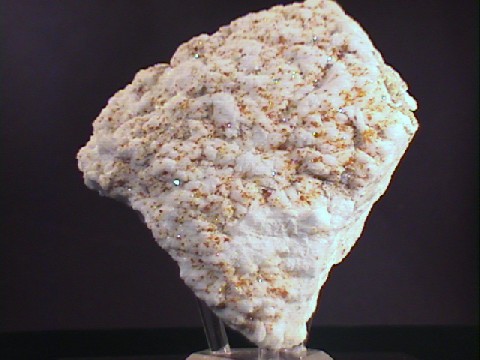 THE
MINERAL MICROLITE
THE
MINERAL MICROLITE
- Chemical Formula: (Ca, Na)2Ta2O6(O, OH, F); Calcium Sodium Tantalum Oxide Hydroxide Fluoride.
- Class: Oxides and Hydroxides
- Group: Pyrochlore
- Uses: A very minor ore of tantalum, as mineral specimens and sometimes cut as a gemstone.
Specimens
Microlite is one of the tantalum/niobium oxides that are generally difficult to distinguish. Fortunately there are few of them that form well shaped octahedral crystals. Microlite crystallizes in the isometric symmetry class and forms fine octahedral crystals that are typically and characteristically modified by other isometric forms. Other members of the Pyrochlore Group also form octahedrons, but can sometimes be reliably differentiated by color, streak and other characteristics.
Microlite generally contains impurities of radioactive elements called rare earths and this produces the slight radioactivity in this mineral. It is occasionally placed in the informal group of minerals called the Rare Earth Oxides, but does not contain a significant amount of these metals.
Microlite is an end member of a solid-solution series between itself and the mineral pyrochlore from where the Pyrochlore Group gets its name. The two minerals have similar structures and properties, but microlite is the tantalum rich end member and pyrochlore is the niobium rich end member. Microlite is found mostly in granitic pegmatite dikes and more rarely in calcite rich rocks called carbonatites. The rarer pyrochlore on the other hand is more common to the carbonatites and alkalic pegmatites called nepheline syenites.
The mineral gahnite also forms octahedrons but is neither a rare earth mineral nor apart of the pyrochlore Group of minerals. Gahnite is a member of the Spinel Group of oxide minerals. Its green color makes it easy to confuse with the green varieties of microlite, but microlite is generally denser and much softer.Remember, this is a slightly radioactive mineral and should be stored away from other minerals that are subject to damage from radioactivity and of course human exposure should be limited !
PHYSICAL CHARACTERISTICS:
- Color is pale yellow, reddish-brown, red, olive or even emerald green.
- Luster is vitreous to resinous.
- Transparency: Crystals are generally translucent with darker specimens being opaque.
- Crystal System is isometric; 4/m bar 3 2/m
- Crystal Habits typically include octahedral crystals that are modified by other isometric forms; also found granular as disseminated grains and massive. Although the name microlite was applied to the mineral for the tiny crystals that were first found, larger crystals up to 2 cm have been found.
- Cleavage is in four directions (octahedral), but is indistinct.
- Fracture is subconchoidal to uneven.
- Hardness is 5 - 5.5
- Specific Gravity is approximately 4.3 - 5.7 (heavy for non-metallic). Variation caused by extent of inclusion of trace metals into the structure.
- Streak is white or pale yellow to brown.
- Other Characteristics: Slightly radioactive.
- Associated Minerals include
quartz,
feldspars,
calcite,
columbite,
tantalite,
zircon,
biotite,
lepidolite,
spodumene
and
simpsonite . - Notable Occurrences include Virgem da Lapa region of Minas Gerais, Brazil; Iveland, Norway; Verutrask, Sweden; Greenland; Wodinga, Australia; Madagascar and Amelia Courthouse, Virginia; Black Hills, South Dakota; Dixon, New Mexico; California; Colorado and many of the rare earth pegmatites of New England, USA.
- Best Field Indicators are crystal habit, luster, fracture, color, hardness, radioactivity, associations, environment and specific gravity.





